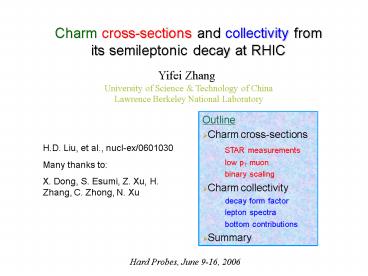Monte Calor Study of Hard and Soft Interactions: - PowerPoint PPT Presentation
1 / 21
Title:
Monte Calor Study of Hard and Soft Interactions:
Description:
Charm quarks are believed to be produced at early stage by initial ... The low pT muon yields are uniform from whatever shape of the charmed hadron. 6/5/09 ... – PowerPoint PPT presentation
Number of Views:101
Avg rating:3.0/5.0
Title: Monte Calor Study of Hard and Soft Interactions:
1
Charm cross-sections and collectivity from its
semileptonic decay at RHIC
Yifei Zhang University of Science Technology
of China Lawrence Berkeley National Laboratory
H.D. Liu, et al., nucl-ex/0601030 Many thanks
to X. Dong, S. Esumi, Z. Xu, H. Zhang, C. Zhong,
N. Xu
Hard Probes, June 9-16, 2006
2
At low pT
3
Why measure charm cross-section?
Mc ? 1.5 GeV Tc, LQCD, Muds
M/E 0
Charm quarks are believed to be produced at early
stage by initial gluon fusions. (M. Gyulassy Z.
Lin, PRC 51 (1995) 2177)
Charm total cross-section should follow number of
binary collisions (Nbin) scaling.
4
Open heavy flavor measurements at RHIC
PHENIX non-photonic electron integral
cross-section at 0.8muon also pT1 GeV/c. (Xiaorong Wang,
SQM06) STAR direct D-meson reconstruction large
combinatorial b.g. STAR EMC non-photonic electron
pT2 GeV/c. STAR TOF non-photonic electron
large conversion b.g. at low pT. STAR low pT muon
pT0.2 GeV. Good constraint to charm
cross-section.
STAR PRL 94, 062301 (2005)
X. Dong USTC
5
We need accurate measurement
PHENIX, PRL 94, 082301(2005)
Systematic errors dominant!
An accurate measurement of charm total
cross-section test pQCD, Nbin scaling, J/?
production, etc
6
How can muon constrain charm x-section?
The muons in 0.16charmed hadron spectrum besides 10.5 b.r.. The
similar spectral shape shows that the muon
uniformly samples the entire charmed hadron
spectrum.
The electron spectrum at pT1 GeV/c can not
constrain charm yields. The low pT muon yields
are uniform from whatever shape of the charmed
hadron.
7
Low pT muon method
Primary particle DCA and muon DCA from pion/Kaon
decay after TPC dE/dx and TOF m2 selections
muon candidates and primary pion candidates after
TPC dE/dx selections.
from HIJING simulation through realistic STAR
detector configuration.
8
Centrality dependence of charm cross-section
Haibin Zhang/Yifei Zhang, SQM06
Low pT ? constrains charm cross section. Within
error bars, consistent with binary scaling.
Charm produced at the initial impact. Larger
than PHENIX data and pQCD.
Charm cross-section at mid-rapidity were
extracted by a combined fit to D0, muon and
electron spectra.
9
At higher pT
Charm collectivity
- decay form factor
- lepton spectra
- bottom contributions
10
Charm leptonic decay form factors
Leptonic decay form factor is much harder than
PYTHIA. Up to a factor of 1.5 around pT 3-4
GeV/c. Consistent with other decay form factors.
M. Cacciari, P. Nason and R. Vogt, PRL 95 (2005)
122001 CLEO Collaboration, J. Yelton Heavy Quarks
and Leptons June 4,2004
PYTHIA uses a simplified vector meson decay form
factor softer PDG form factor is from three
decay channels
11
Are lepton spectra sensitive to flow?
S. Batsouli, et al, Phys.Lett.B 557 (2003) 26
- Electron spectra cannot disentangle different
charm hadron shapes at low pT
12
Charm collectivity from BW
Haibin Zhang/Yifei Zhang, SQM06
BlastWave model-dependent fit shows charm has
collectivity. The sensitivity of electron
spectrum to charm spectrum shape is weak.
13
Assumption for bottom contributions
Since non-photonic electron strongly lose energy,
bottom contribution seems small in Au Au
collisions. So we assume ?bbar / ?ccbar
0.30.7
NLO, FONLL prediction R. Vogt,
hep-ph/0502203 ?bbar / ?ccbar 0.2 2.6
14
Lepton v2 from heavy flavor hadron decay
(a) X. Dong, et al., PLB 597 (2004) 328 (b)
Assumed c/b-hadron v2 (c) Decayed electron v2.
(d) cb ? e v2 compare to PHENIX data
15
Bottom contribution is negligible!!
The decayed electron v2 from assumed decreasing
c-hadron v2 can describe PHENIX data.
YES Consistent with energy loss! YES Bottom
contribution is negligible up to pT5 GeV/c.
16
Summary
- We develop the low pT (2 GeV/c) muon method to
constrain charm cross-sections. Charm
cross-sections at mid-rapidity are extracted from
a combination of the three different measurements
at STAR. - The cross-section is found to follow binary
scaling within error bars. It is larger than
PHENIX data and pQCD calculation. - The charm decay form factor was studied.
BlastWave model-dependent fit shows charm has
collectivity. - Comparison between simulation and PHENIX data
shows charm flow strongly. - From our assumptions, PHENIX non-photonic
electron v2 can be reproduced by simulation
without bottom contribution. Bottom contribution
is negligible up to pT5 GeV/c.
17
- Backup slides
18
PHENIX charm cross-section
Run2pp ?- FONLL Solid line and band PYTHIA w/o
scaling the charm contribution dotted line
PHENIX, PRL 94, 082301(2005)
PHENIX forward muon also more than 5 times of
pQCD. (Xiaorong Wang, SQM06)
19
RAA how the electron sensitive?
20
How high pt can BW fit to?
- Charm hadron pTGeV/c
- Sensitive to different freeze-out T120MeV,
bm0.7T220MeV, bm0.36 - STAR PHENIX data consistent
21
(No Transcript)











![The acceptability of illicit drug use in the Netherlands and Norway: a comparative study [preliminary results] PowerPoint PPT Presentation](https://s3.amazonaws.com/images.powershow.com/8579999.th0.jpg?_=20170308115)



















